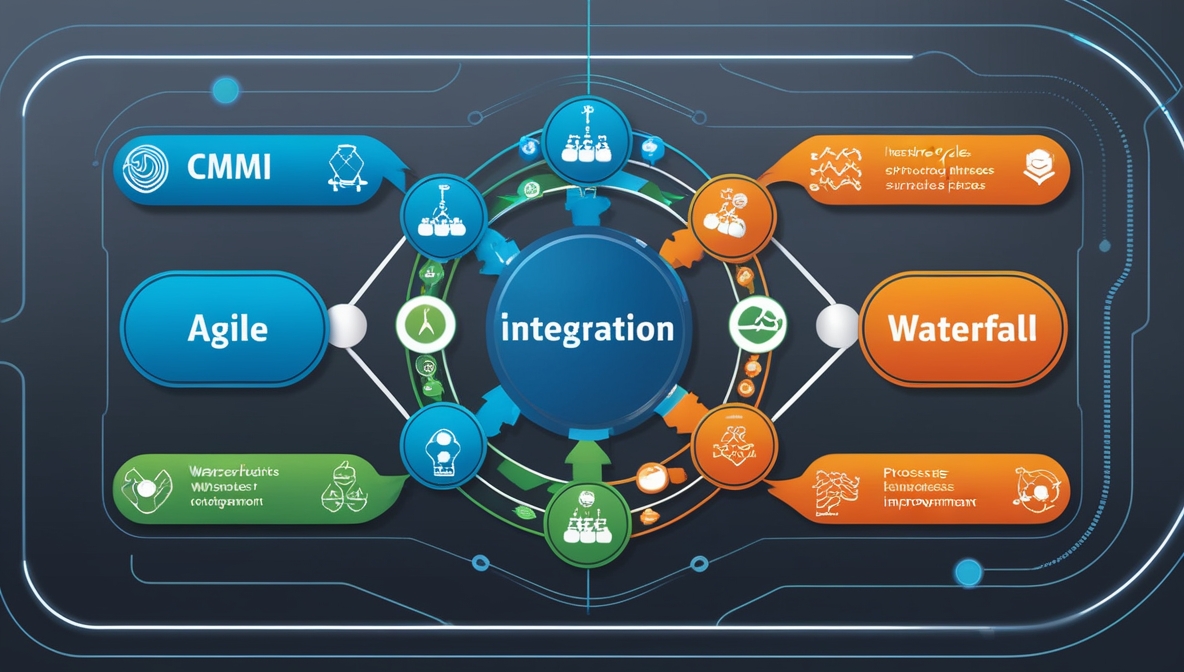This presentation discusses using Capability Maturity Model Integration (CMMI) methodology with Agile and Waterfall development methodologies.
This analysis provides in-depth insights into the integration of the Capability Maturity Model Integration (CMMI) framework with Agile and Waterfall development methodologies. It explores the balance between agility and discipline in software development, the hierarchy of program governance, and the roles of various teams and councils in this integration. The document also examines the attributes of different development methodologies, offering guidance on choosing the most suitable approach for different project types.
In the intricate world of software development, the challenge of aligning diverse development methodologies with quality and process models like Capability Maturity Model Integration (CMMI) is a common hurdle. Teams often struggle with the question of whether to embrace the agility of methods like Agile or the structured approach of Waterfall. This indecision can lead to inefficiencies, misalignments between processes and project goals, and ultimately, a compromise in the quality and delivery of software products.
This analysis on integrating CMMI with Agile and Waterfall methodologies provides a comprehensive exploration of this critical intersection. It begins by delineating the core aspects of agility and discipline, two seemingly contrasting approaches in software development. Understanding these concepts is key to appreciating how they can coexist and complement each other when integrated with CMMI.
The document further outlines the hierarchy of program governance essential for such integration, detailing the roles and responsibilities of various boards and councils. This structure is crucial for maintaining oversight and ensuring that the integrated methodologies align with organizational objectives and CMMI standards.
Moreover, the document provides a comparative analysis of approved and unapproved development methodologies in the context of CMMI. This includes a detailed examination of the attributes of Pure Waterfall, Modified Waterfall, Iterative, Incremental, and other methodologies, offering guidance on selecting the most appropriate approach based on specific project characteristics.
In essence, this analysis offers a strategic roadmap for organizations and software development teams facing the challenge of integrating diverse methodologies with CMMI. It provides a framework for understanding and implementing an approach that harnesses the strengths of both Agile and Waterfall methodologies, ensuring process discipline while maintaining the flexibility and responsiveness crucial in today's dynamic software development landscape.
Main Contents:
-
- Balancing Agility and Discipline in Software Development: An exploration of the qualities of being agile versus disciplined and how these can coexist in software development.
- Program Governance Hierarchy: A detailed look at the structure of program governance essential for integrating CMMI with Agile and Waterfall methodologies.
- Roles and Functions of Development Teams and Councils: Insight into the responsibilities of various teams and councils in managing and tailoring the development process.
- Comparative Analysis of Development Methodologies: Analysis of approved and unapproved development methodologies in the context of CMMI, including Waterfall, Agile, and their variants.
- Method Selection Based on Project Attributes: Guidelines on selecting the most appropriate development methodology based on the specific characteristics of a project.
Key Takeaways:
-
- Integrating CMMI with Agile and Waterfall methodologies requires balancing the flexibility of Agile with the structured approach of Waterfall.
- Effective program governance and clear roles are crucial for the successful integration of these methodologies with CMMI.
- Understanding the attributes and applicability of different development methodologies is key to selecting the right approach for a given project.
- This analysis provides a comprehensive framework for software development teams to optimize their processes by effectively combining the strengths of CMMI with Agile and Waterfall methodologies.
- The document serves as a strategic guide for organizations aiming to enhance their software development practices through a balanced and integrated approach.
CIOs can utilize this analysis on integrating CMMI with Agile and Waterfall methodologies to address a range of challenges in the realm of software development and process management:
- Balancing Flexibility and Structure: The document provides insights on how to balance the agility of Agile methods with the structured approach of Waterfall, enabling CIOs to tailor their development processes to diverse project needs while maintaining quality and consistency.
- Enhancing Process Maturity and Compliance: By integrating CMMI, a renowned process improvement framework, with Agile and Waterfall methodologies, CIOs can elevate the maturity level of their software development processes, ensuring compliance with industry standards and best practices.
- Effective Governance and Oversight: The analysis outlines a hierarchy of program governance, offering a framework for CIOs to establish clear oversight mechanisms. This ensures that software development aligns with organizational goals and CMMI standards.
- Optimizing Resource Allocation: By understanding the attributes and applicability of various development methodologies, CIOs can make more informed decisions about resource allocation, ensuring that projects are executed with the right balance of speed, quality, and efficiency.
- Managing Change in Development Practices: The document provides a roadmap for CIOs to navigate the challenges of introducing new methodologies or integrating existing ones, facilitating smoother transitions and greater acceptance among development teams.
- Strategic Decision Making in Methodology Selection: With a comparative analysis of different development methodologies, CIOs are better equipped to select the most appropriate methods for specific projects, enhancing the overall effectiveness and success of software development initiatives.
In summary, this analysis serves as a valuable tool for CIOs seeking to optimize their software development processes by effectively integrating CMMI with both Agile and Waterfall methodologies, addressing the dynamic and varied demands of modern software projects.

